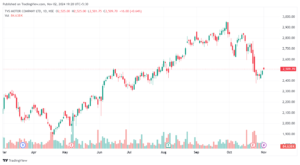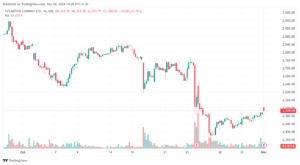TVS Motor Company, one of India’s leading two-wheeler manufacturers, has a rich history rooted in innovation and commitment to quality. Founded in 1978, TVS Motor is part of the larger TVS Group, which was initially established in 1911 by T.V. Sundaram Iyengar. The company started as a provider of public transportation services, with its first business being a bus fleet service in Madurai, Tamil Nadu. Over the decades, TVS Group expanded, exploring various industries, including automotive, finance, and electronics.
In 1980, TVS Motor entered the Indian two-wheeler market, which at the time was dominated by a few players. They launched their first moped, the TVS 50, India’s first two-seater moped. This model gained widespread popularity due to its affordable price and fuel efficiency. The success of TVS 50 helped TVS Motor establish a foothold in the Indian market. Throughout the 1980s, TVS expanded its product range and reputation, building a loyal customer base.
TVS partnered with Suzuki Motor Corporation of Japan in 1984, marking a significant milestone in its journey. This collaboration, known as “TVS Suzuki,” brought advanced Japanese technology to India, which helped TVS develop high-quality, reliable motorcycles and scooters. The partnership led to the launch of several popular models, including the Suzuki Samurai and the Suzuki Shogun. These models quickly became popular due to their performance and style, especially among young riders. TVS Suzuki’s collaboration ended in 2001, allowing TVS to operate independently under the TVS Motor Company name.
After the split, TVS Motor focused on developing its own technology and product line. It launched the TVS Victor, a commuter bike that achieved great success in the early 2000s. Known for its fuel efficiency and reliability, the Victor became one of the best-selling motorcycles in India. Building on this success, TVS Motor continued to innovate and expand, entering various segments of the two-wheeler market.
In 2005, TVS introduced the Apache series, a line of sporty motorcycles that quickly gained a reputation for performance and style. The Apache series helped TVS capture a share of the sports bike segment, which had previously been a niche market. The Apache’s popularity encouraged TVS to invest more in high-performance motorcycles, strengthening its position in the Indian market.
TVS Motor also focused on the scooter segment, launching the TVS Scooty in the early 2000s. Designed with lightweight and user-friendly features, the Scooty appealed to a wide range of customers, especially women and young riders. It became a household name, helping TVS establish itself as a leader in the scooter market.
In recent years, TVS Motor has ventured into the electric vehicle (EV) market. It launched its first electric scooter, the TVS iQube, in 2020, aiming to tap into the growing demand for eco-friendly transportation. The iQube represents TVS’s commitment to innovation and sustainability, combining advanced technology with a user-friendly design.
TVS has expanded internationally, exporting two-wheelers to over 60 countries worldwide. Its consistent quality, strong distribution network, and focus on customer satisfaction have made TVS a trusted brand in global markets.
Throughout its history, TVS Motor has won numerous awards for quality, design, and customer satisfaction. It has earned a reputation as one of India’s most respected two-wheeler manufacturers. Its commitment to innovation and quality has allowed it to stay competitive in the ever-evolving automotive industry.
From its early beginnings in public transportation to its current status as a leader in motorcycles, scooters, and EVs, TVS Motor’s journey reflects a legacy of growth, resilience, and dedication. Today, it continues to push boundaries in the two-wheeler industry, paving the way for a more innovative and sustainable future in transportation.
With a current market capitalization of ₹1,19,236 Cr and a price of ₹2,510 per share, the stock has shown substantial growth over the years. TVS Motor’s journey reflects the evolving trends in India’s automotive industry, capturing investor interest through its consistent performance and strong brand value.
Key Financial Metrics
- Current Price and Range:
- Current Price: ₹2,510
- 52-Week High: ₹2,958
- 52-Week Low: ₹1,600
The current price reflects a consolidation phase after touching its 52-week high. The stock remains resilient, trading within a narrow range in recent sessions, indicating investor confidence.
- Valuation Ratios:
- P/E Ratio: 63.2
- Book Value: ₹163
- Price to Book Ratio: 15.4
The P/E ratio suggests that the stock trades at a premium, possibly indicating high investor expectations. However, it also highlights the stock’s relative expensiveness compared to its book value.
- Profitability Ratios:
- ROCE (Return on Capital Employed): 14.7%
- ROE (Return on Equity): 26.6%
Both ROCE and ROE are healthy, showing efficient utilization of capital and shareholder equity. An ROE of 26.6% is particularly impressive, signaling strong returns to investors.
- Dividend Yield: 0.32%Although the dividend yield is modest, TVS Motor has maintained a steady dividend payout ratio of 21.3%, which demonstrates commitment to shareholders.
Financial Performance and Growth
Quarterly Results
The company’s quarterly performance reflects solid growth:
- Revenue Growth: Quarterly sales have shown consistent growth, reaching ₹11,302 Cr in the latest quarter.
- Operating Profit Margin (OPM): The OPM has remained steady around 14%, indicating efficient cost management and strong pricing power.
- Net Profit: The company reported a net profit of ₹588 Cr for the latest quarter, marking a substantial improvement in profitability.
Historical Performance
- Revenue and Expenses: Over the years, TVS Motor’s revenue has shown a compound annual growth rate (CAGR) of around 14%, reflecting the company’s resilience in a competitive market.
- Net Profit: The net profit has grown at a CAGR of 18.2% over the past five years, highlighting the company’s consistent financial performance and robust market position.
Cash Flow Analysis
The cash flow statement reveals significant fluctuations in cash from operations. Although there was a substantial cash outflow in certain years, the overall trend indicates adequate cash flow for expansion and operational needs.
Technical Analysis: Price Movements
The technical charts reveal key insights into the price trends of TVS Motor Company stock:
Daily Chart Analysis
The daily chart highlights a gradual rise in the stock price from early March through to mid-October, indicating a robust bullish trend. This upward momentum pushed the stock to a peak of around ₹2,958. However, recent weeks show a notable retracement, with the stock currently trading at ₹2,510, reflecting a dip from its highs. The recent decline might suggest profit-booking or market reactions to external factors. The volume bars show fluctuating interest, with higher volumes in certain sessions, possibly reflecting more active participation from traders during specific market moves.

The support levels are visible around the ₹2,400 mark, as the price rebounded after testing this range. Resistance levels can be identified near ₹2,700, where the stock faced selling pressure in prior sessions. The recent uptick after touching lower levels suggests a potential recovery, but the stock needs to break above resistance levels for a stronger bullish confirmation.
Hourly Chart Analysis
The hourly chart presents a closer view of the recent price movements. It highlights a downtrend from October, with some recovery attempts after the stock hit lows around ₹2,480. The current price movement shows consolidation in the ₹2,500 range, with minor gains and steady volumes. The rebound observed in the last few trading hours might suggest a potential short-term uptrend, with traders possibly considering it a buy opportunity at these lower levels.

The volume in the hourly chart remains moderate, suggesting cautious buying interest. Traders may be awaiting further signals, such as a breakout above immediate resistance or confirmation of support around the current levels.
Key Takeaways
- Support: Around ₹2,400; observed recovery after testing this level.
- Resistance: Near ₹2,700; stock needs to break above for stronger upward momentum.
- Volume: Moderate on both charts, showing cautious but steady interest from traders.
- Short-term Outlook: Consolidation with potential for recovery if it breaks above resistance.
The charts suggest that while TVS Motor has experienced a pullback, it is showing signs of stability and could attract renewed interest if it holds support levels and breaks resistance.
Comparison with Peers
Peer Analysis:
| Company | CMP (₹) | P/E | Market Cap (₹ Cr) | Dividend Yield (%) | ROCE (%) |
|---|---|---|---|---|---|
| Eicher Motors | 4,953.60 | 32.45 | 1,35,758.71 | 1.03 | 31.14 |
| Hero Motocorp | 5,020.50 | 24.70 | 1,00,400.02 | 2.29 | 29.09 |
| TVS Motor Company | 2,509.70 | 63.18 | 1,19,235.85 | 0.32 | 14.68 |
| Ola Electric | 82.84 | – | 36,539.31 | 0.00 | -32.13 |
Compared to its peers, TVS Motor trades at a higher P/E ratio, reflecting premium valuation in the market. The ROCE is lower than peers like Eicher Motors and Hero Motocorp, suggesting room for improvement in capital efficiency. The lower dividend yield indicates a focus on reinvestment over income distribution.
Strengths and Weaknesses
Strengths:
- Debt Reduction: TVS Motor has successfully reduced its debt, enhancing its financial stability.
- Strong Profit Growth: The company has achieved a profit CAGR of 18.2% over the last five years.
- Healthy Dividend Payout: With a payout ratio of 21.3%, TVS Motor balances reinvestment and shareholder returns.
Weaknesses:
- High Valuation: The stock is trading at 15.4 times its book value, which may limit upside potential.
- Low Dividend Yield: At 0.32%, the yield is modest, indicating limited appeal for income-focused investors.
Market Sentiment and Investor Outlook
Investors remain optimistic about TVS Motor due to its strong market position and growth trajectory. The company’s focus on product innovation, combined with its strategic initiatives, has cemented its place in the industry. However, the high valuation may deter conservative investors.
The Indian automobile sector is poised for growth, with rising demand for two-wheelers driven by factors such as increasing disposable income, urbanization, and government initiatives promoting sustainable transportation.
Future Prospects
TVS Motor has several growth drivers that make it an attractive investment option:
- Expansion in Electric Vehicles (EVs): TVS Motor’s foray into the electric vehicle segment aligns with the industry’s shift toward sustainable mobility. The company’s focus on developing a diverse EV portfolio positions it for long-term growth.
- Global Expansion: TVS Motor is expanding its presence in international markets, with a focus on emerging economies. This strategy provides growth opportunities beyond the domestic market.
- Innovation in Product Offerings: The company’s commitment to product innovation, including high-performance bikes and electric scooters, enhances its competitive edge.
TVS Motor Company stands as a resilient and dynamic player in the Indian automotive sector. Its consistent financial performance, coupled with a strong brand presence, has contributed to its robust market position. Although the high valuation poses a challenge, the company’s growth prospects, including its expansion into EVs and international markets, underscore its long-term potential.
Investors seeking exposure to the automotive sector may find TVS Motor an appealing choice. However, caution is advised due to the premium valuation, and potential investors should consider the stock’s growth trajectory relative to its price.
In summary, TVS Motor’s balance of growth and stability, along with its strategic initiatives, makes it a compelling option for investors looking for exposure to India’s burgeoning automotive industry. The stock’s performance over the past year reflects strong investor confidence, and its future looks promising with continued innovation and expansion.
ALSO READ: Syrma SGS Technology Ltd: Buy, Hold or Sell




